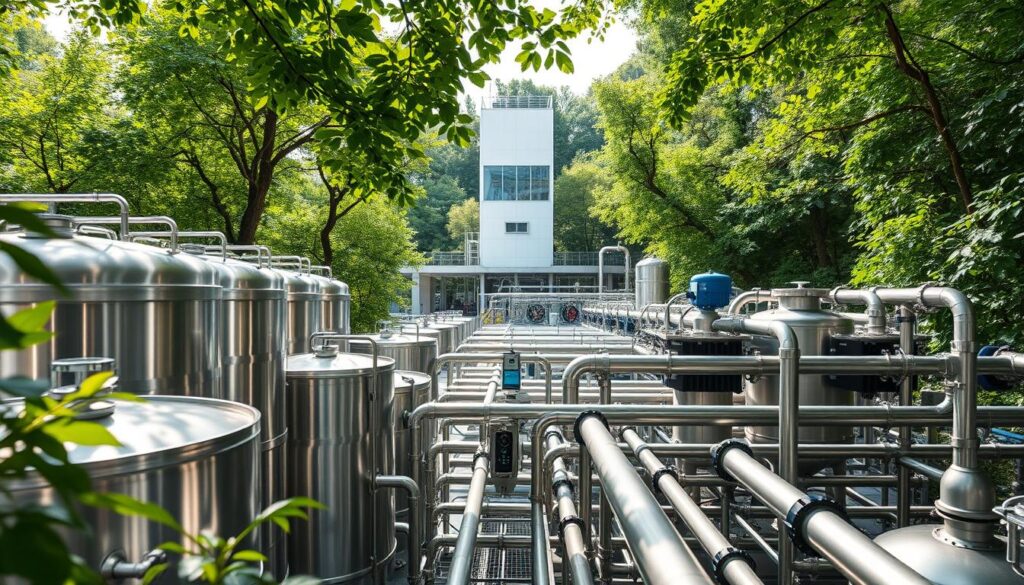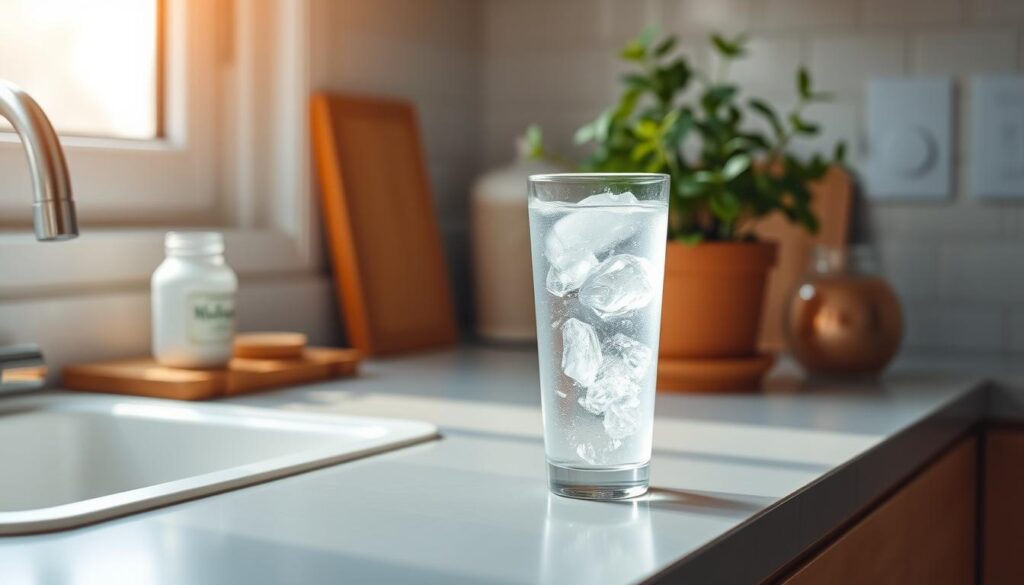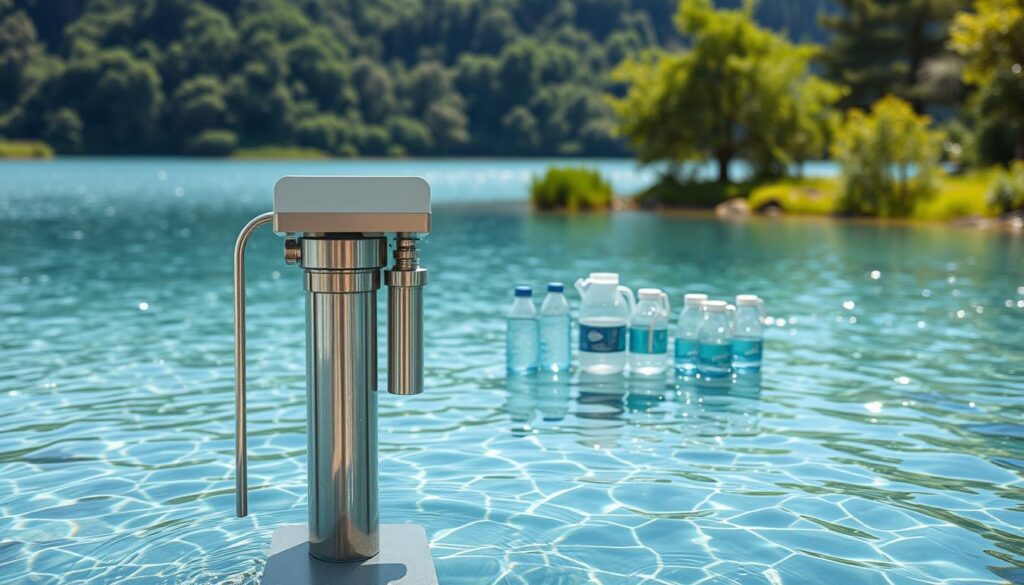Thinking about clean water technology makes me realize how important it is. Billions of people around the world don’t have access to safe drinking water. This is a basic need for health and growth.
The World Health Organization (WHO) says we need water sanitation solutions now more than ever. In this guide, I’ll cover the key points of water sanitation. This includes its benefits, challenges, and new solutions.
By the end of this guide, you’ll know how to improve your home’s water supply. This will make your home healthier and safer for everyone.
Key Takeaways
- Understanding the importance of water sanitation for public health
- Exploring innovative clean water technologies
- Identifying effective water sanitation solutions for your home
- Learning about the benefits and challenges of water sanitation
- Making informed decisions about your water supply
Understanding Water Sanitation
Understanding water sanitation is key to sustainable water management. It involves making water safe for drinking and use. This is done through various processes and practices.
What is Water Sanitation?
Water sanitation means removing harmful substances from water. This makes it safe for drinking and other uses. It uses water purification methods like physical, chemical, and biological treatments. Good water sanitation stops waterborne diseases and keeps people healthy.
Importance of Water Quality
Water quality is very important for water sanitation. Bad water quality can cause health problems like diarrheal diseases and cholera. The United Nations says clean water and sanitation are key for sustainable development. Good water quality comes from strong water treatment and effective wastewater management.
Key Components of Water Sanitation
The main parts of water sanitation are:
- Water treatment: This removes contaminants through methods like filtration and disinfection.
- Wastewater management: Proper disposal and treatment of wastewater prevent pollution and protect health.
- Hygiene practices: Good hygiene, like handwashing with soap, stops disease spread.
Knowing these parts and using effective water sanitation can greatly improve water quality and health. The Rotary Foundation’s Water, Sanitation, and Hygiene Guidelines stress the need for community assessments and sustainability. They show the importance of a complete approach to water sanitation.
Common Water Sanitation Challenges
Despite progress in water sanitation, many challenges remain. The UN World Water Development Report 2023 highlights a looming global water crisis. It points to population growth, urbanization, and climate change as main causes.
Water sanitation challenges stem from various factors. A big concern is contamination sources that harm water quality. These can include industrial waste and agricultural runoff, affecting wastewater treatment systems.
Contamination Sources
Contamination sources vary and can be grouped into several types:
- Agricultural runoff, which includes fertilizers and pesticides
- Industrial waste, comprising chemicals and heavy metals
- Domestic sewage, which can contain pathogens and other harmful substances
These contaminants can severely affect water quality. It’s vital to have effective water quality control measures in place.
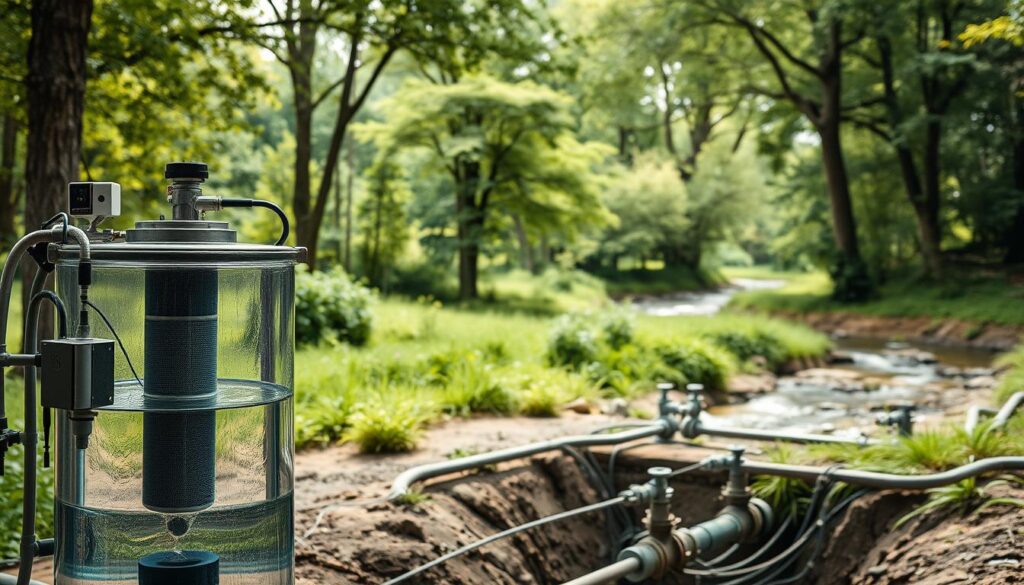
Infrastructure Limitations
Aging infrastructure and lack of investment in water sanitation facilities are big challenges. Many wastewater treatment systems need updates or replacements to meet today’s standards.
The infrastructure limitations affect treatment and distribution. They lead to inefficiencies, losses, and strain on resources.
Climate Impact on Water Systems
Climate change worsens water sanitation challenges by changing weather patterns and increasing extreme weather events. This can cause:
- More frequent flooding, which can overwhelm wastewater treatment plants
- Droughts, which can deplete water sources and concentrate contaminants
Understanding and mitigating climate change’s impact on water systems is key. It’s essential for the long-term sustainability of water sanitation efforts.
By tackling these common challenges, we can improve water sanitation. This ensures communities have access to clean and safe water.
Types of Water Sanitation Solutions
I’ve found several key water sanitation solutions that greatly improve public health. These solutions are vital for ensuring communities have access to clean water.
Centralized Water Treatment Systems
Centralized water treatment systems work well for big areas. They have complex setups, like treatment plants and networks, to clean water for many people. These systems are advantageous because they can serve a lot of people. But, they need a lot of money and upkeep.
Decentralized Systems
Decentralized systems are flexible and good for smaller groups. They include point-of-use water treatment and community water management. These systems are great for places where big systems can’t work because of money or location.
Rainwater Harvesting
Rainwater harvesting is a way to get clean water without using groundwater or surface water. It collects and stores rainwater for drinking, irrigation, and more. Rainwater harvesting works for both individuals and communities.
Using these different water sanitation solutions helps communities get better access to clean water. This improves public health and overall well-being.
Innovative Technologies in Water Sanitation
Water scarcity and contamination are big problems worldwide. Innovative technologies in water sanitation are key to solving these issues. The World Health Organization highlights the importance of these technologies in making water better and more accessible.
I’ve seen how innovative water treatment solutions change lives. They improve water quality and help us live more sustainably.
Membrane Filtration
Membrane filtration is a top choice for cleaning water. It uses special membranes to block out harmful stuff like bacteria and viruses. This method is very good at removing pollutants.
Want to learn more about water purification? Check out my guide on mastering purification methods at home.
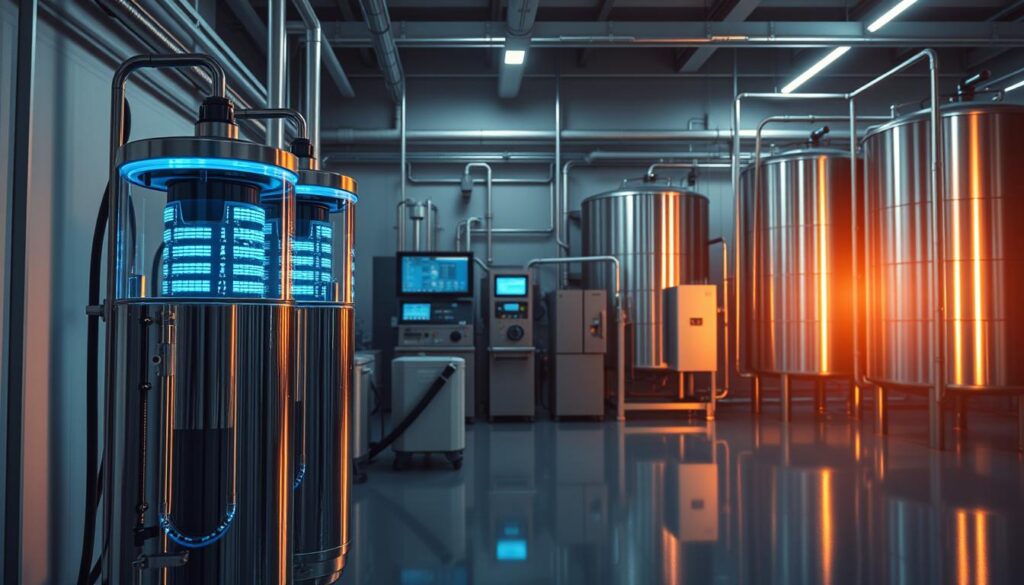
Solar Water Purification
Solar water purification is a green and efficient way to clean water. It uses the sun’s energy to purify water, without needing fossil fuels. This makes it perfect for places without access to traditional power sources.
Bioremediation Techniques
Bioremediation uses living things to clean water. It’s a great way to fix water that’s been polluted. This method works well against organic pollutants and can be used with other cleaning methods.
| Innovative Technology | Description | Benefits |
|---|---|---|
| Membrane Filtration | Uses semi-permeable membranes to remove contaminants | Highly effective against bacteria, viruses, and heavy metals |
| Solar Water Purification | Harnesses solar energy to purify water | Sustainable, energy-efficient, and ideal for off-grid communities |
| Bioremediation Techniques | Utilizes living organisms to clean pollutants | Effective against organic pollutants, can be used with other technologies |
Implementing Water Sanitation Solutions
Putting water sanitation solutions into action means looking at the current situation closely and getting the community involved. It’s key for keeping communities healthy and happy all over the world.
Steps for Assessment
The first thing to do is check the water quality and sanitation setup. Look for where contamination comes from, check the water treatment places, and know the local water situation. Eco-friendly water sanitation solutions work best when they fit the community’s needs.
It’s also important to learn about the community’s water use and sanitation habits. This info helps create plans that the community will actually use.
Community Involvement
Getting the community involved is key to success. Working with local people makes sure the solutions are right and will last. The Water, Sanitation, and Hygiene Guidelines for Global Grant Funding stress the need for community help.
When the community helps plan and decide, they feel more connected. This way, they can spot problems and chances early. This teamwork leads to better and sustainable water sanitation solutions.
Sustainable Practices
Using practices that last is essential for water sanitation projects. This means using local materials, saving water, and choosing green technologies. Eco-friendly water sanitation solutions help keep water resources safe and protect the environment.
Also, sustainable water sanitation can save money and improve life quality for people in the community.
Regulations and Standards
Regulations and standards are key to keeping water safe. They help protect our health and the environment.
In the United States, the Environmental Protection Agency (EPA) sets water quality standards. This is just one part of a bigger system.
Overview of EPA Guidelines
The EPA makes rules for drinking water. These rules cover what’s allowed in water and how it’s treated. The goal is to keep our water clean and safe.
EPA guidelines include rules for many contaminants. This means water companies must follow strict rules to keep our water safe.
State-Level Regulations
States also have their own water rules. Sometimes, these rules are stricter than federal ones.
State regulations can tackle local water problems. For example, they might deal with pollution from farms or factories. This helps tailor water safety efforts to local needs.
International Standards
Worldwide, the World Health Organization (WHO) sets global water standards. These standards help countries create their own rules.
The WHO’s guidelines cover many aspects of water safety. Countries use these guidelines to shape their own water regulations.
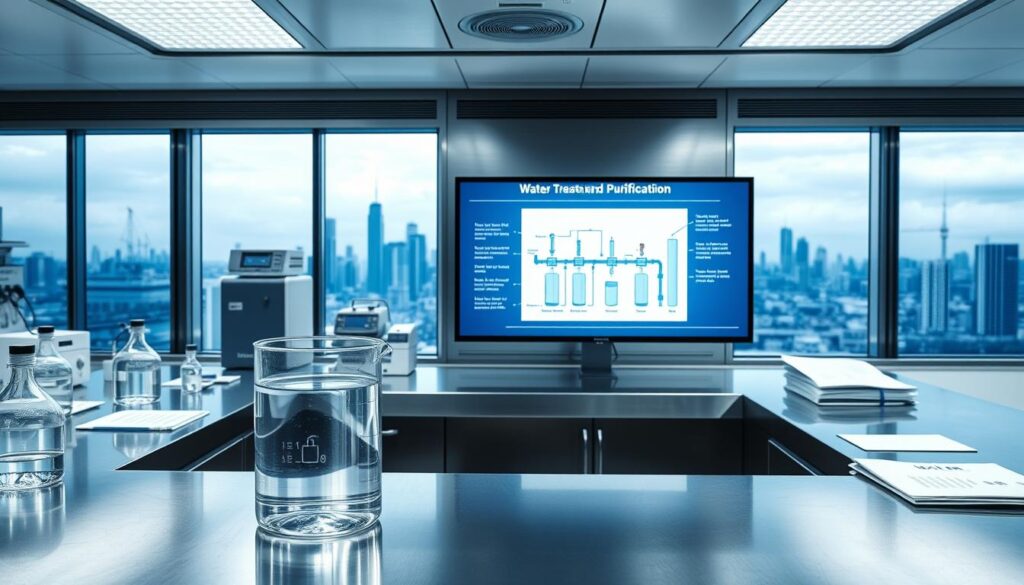
In summary, following regulations and standards is critical for good water sanitation. By sticking to these rules, we can provide clean water to people everywhere.
Best Practices in Water Management
Exploring water sanitation shows that good water management is key. It involves many strategies to keep water safe and sustainable.
Regular Maintenance and Monitoring
Keeping water systems in check is vital. Regular checks and upkeep stop problems and keep water clean. The UN World Water Development Report says managing water well is key to keeping it safe.
Some important tasks include:
- Checking water treatment plants and systems often
- Doing routine maintenance, like cleaning filters
- Watching water quality, like pH and turbidity
Public Education on Water Sanitation
Teaching people about water is important. It helps save water and keep it clean. The UN World Water Development Report says teaching the public is key to water safety.
“Water is a critical component of human health, and its management is essential for sustainable development.”
Partnerships for Better Solutions
Working together can help improve water services. Governments, NGOs, and private companies can share resources and ideas. This leads to better water management and services.
| Partnership Type | Description | Benefits |
|---|---|---|
| Government-NGO Partnerships | Collaborations between government agencies and NGOs to implement water sanitation projects | Increased funding and expertise for water sanitation initiatives |
| Private Sector Partnerships | Partnerships between private companies and water sanitation authorities to develop innovative solutions | Access to new technologies and management practices |
| Community-Based Partnerships | Collaborations between local communities and water sanitation authorities to promote public education and awareness | Increased community engagement and participation in water sanitation initiatives |
By following these best practices, we can make water management sustainable. This improves life for people all over the world.
Case Studies of Successful Implementation
The use of wastewater treatment systems and clean water technology has led to many success stories worldwide. These stories offer valuable lessons for future projects. By looking at these case studies, we can learn effective strategies for improving water sanitation.
Urban Water Sanitation Projects
In cities, the challenge of providing clean water is big. High population densities and infrastructure needs make it tough. But, some cities have found ways to overcome these challenges.
For example, Singapore has used advanced wastewater treatment systems. They include membrane bioreactors and advanced oxidation processes. This ensures a sustainable water supply for the city.
Rotterdam, Netherlands, is another example. They have a water management system that includes green infrastructure and smart water management technologies. This helps reduce urban flooding and improve water quality.
| City | Technology Implemented | Outcome |
|---|---|---|
| Singapore | Membrane Bioreactors, Advanced Oxidation Processes | Sustainable water supply, improved water quality |
| Rotterdam | Green Infrastructure, Smart Water Management | Reduced urban flooding, improved water quality |
Rural Development Success Stories
In rural areas, wastewater treatment systems have greatly improved life. For example, in rural India, community-based initiatives have introduced low-cost water treatment solutions. These include slow sand filtration and solar disinfection to fight waterborne diseases.
These efforts not only improve health but also empower local communities. They get involved in managing and maintaining water sanitation systems.
Lessons Learned from Failures
There are many success stories, but we can also learn from failures. A key lesson is the importance of solutions that fit the local context and community engagement. For example, a project in a developing country failed because it didn’t consider local water usage practices and community preferences.
On the other hand, projects that listened to local insights and adapted to community needs have been more successful. This shows the value of adaptive management and engaging stakeholders.
By studying successes and failures, we can improve our approaches to water sanitation. This will help us get closer to our goal of providing clean water for everyone.
Future Trends in Water Sanitation Solutions
New trends and technologies will shape the future of water sanitation. The world faces water scarcity, contamination, and climate change. So, we need innovative water treatment solutions more than ever.
The World Health Organization (WHO) and others are looking into new technologies. They aim to tackle water sanitation challenges. A big focus is on smart water management technologies.
Smart Water Management Technologies
Smart water management is changing how we handle water sanitation. It uses IoT sensors and data analytics. These tools help monitor and manage water systems better.
IoT sensors find leaks and oddities in water systems. This lets us act fast. Data analytics predict water needs. This helps utilities plan better.
Increased Focus on Resilience
Climate change is affecting water resources. We need water solutions that are strong and flexible. This means developing water purification methods that can handle extreme weather.
Being resilient in water sanitation also means protecting sources from contamination. We must keep treatment going during emergencies.
| Resilience Measures | Description | Benefits |
|---|---|---|
| Protecting water sources | Implementing measures to prevent contamination | Reduced risk of waterborne diseases |
| Emergency preparedness | Developing contingency plans for extreme weather events | Ensured continuity of water services |
| Redundant systems | Implementing backup systems to ensure continued operation | Enhanced reliability of water sanitation services |
Emerging Funding Opportunities
Creating new water sanitation solutions needs a lot of money. Luckily, new funding options are available. For more on trends and funding, check Idrica’s blog on water trends.
Groups like governments, international organizations, and private investors are funding water sanitation projects. They see its importance.
In conclusion, the future of water sanitation will be shaped by new trends and technologies. This includes smart water management, a focus on resilience, and new funding. By using these, we can make water sanitation better, more efficient, and sustainable.
Taking Action for Clean Water
We all want a future where everyone has safe, clean water. It’s up to us to make it happen. By using eco-friendly water solutions and supporting sustainable water practices, we can make a big difference.
Personal Contributions
I can help by making simple changes in my daily life. Like using less water and supporting groups that work on water projects. World Water Day and World Toilet Day remind us of the need to act on water issues.
Advocacy Resources
There are many ways to make a bigger impact. Organizations working on water issues offer tools and chances to get involved. With their help, we can push for better water policies and systems.
Local Initiatives
Joining local efforts is a great way to help. Community projects often focus on clean water and teaching water conservation. By supporting these efforts, we can make sure our communities have access to clean water.
FAQ
What is water sanitation, and why is it important?
Water sanitation means making water safe to drink by removing harmful stuff. It’s key to stop waterborne diseases and keep communities healthy.
What are the common challenges in implementing water sanitation solutions?
Challenges include finding and fixing contamination sources, dealing with old infrastructure, and climate change’s effects. These make it hard to treat and distribute clean water.
What types of water sanitation solutions are available?
There are many solutions like big water treatment plants, smaller systems, and catching rainwater. Each has its own good and bad points, depending on the situation.
How can innovative technologies improve water sanitation?
New tech like membrane filters, solar purifiers, and bioremediation can really help. They offer effective and green ways to clean water.
What are the key components of water sanitation?
Important parts are treating water, managing wastewater, and keeping things clean. Knowing these helps make water safer and healthier for everyone.
How can I contribute to improving water sanitation in my community?
You can help by joining local efforts, pushing for better policies, and using water wisely. Also, throw away waste properly.
What role do regulations and standards play in water sanitation?
Rules and standards, like EPA guidelines, are vital for safe water. Following them ensures clean water for everyone.
How can smart water management technologies enhance water sanitation?
Smart tech, like IoT sensors and data tools, makes water services better. They help monitor and fix problems in real time.
What are some best practices in water management for sustainable water sanitation?
Good practices include keeping systems in check, teaching people about water, and working together. This uses everyone’s skills and resources.
What is the significance of community involvement in water sanitation projects?
Getting the community involved is key. It makes sure solutions fit local needs, making them more effective and lasting.
How does climate change impact water sanitation, and what can be done to mitigate its effects?
Climate change makes water problems worse by changing weather and causing extreme events. To fight this, we need strong, adaptable water solutions and practices.

